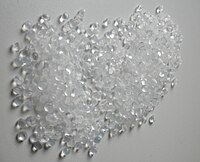
Photo from wikipedia
Abstract Co-continuous morphology in polymer blends has been well demonstrated to reduce percolation threshold and enhance electrical conductivity by selective dispersion of carbon nanotubes in one phase or at interfaces.… Click to show full abstract
Abstract Co-continuous morphology in polymer blends has been well demonstrated to reduce percolation threshold and enhance electrical conductivity by selective dispersion of carbon nanotubes in one phase or at interfaces. In this work, a flexible, co-continuous, and conductive poly(ethylene-co-1-octene)/thermoplastic polyurethane/multi-walled carbon nanotube (POE/TPU/MWCNT) composite has been fabricated by controlling the dispersion of MWCNTs in the TPU phase. The interfacial interaction between the two polymers in the composites has been enhanced by using a gentle crosslinking reaction. The percolation threshold of the composites decreased from 0.43 to 0.29 vol% and electrical conductivity rose more than one order of magnitude after gentle crosslinking because of the very continuous TPU/MWCNT phase, the MWCNT fillers selective distribution, and the strong interfacial interaction between the two polymers. Furthermore, the complex viscosity, storage modulus, tensile strength, and elongation at break of the composites were improved by the gentle crosslinking reaction. For example, the composites with 0.58 vol% MWCNT fillers achieved 1.4- and 2.4-fold improvement in tensile strength and elongation at break after gentle crosslinking, respectively. In addition, the flexibility of the composites was well maintained by the gentle crosslinking reaction, resulting in excellent piezoresistive behavior of the composites. The stability and reliability of the piezoresistive response of the composites were enhanced by the gentle crosslinking reaction, owing to the stability of the MWCNT conductive network and the strong interfacial interaction. We propose that a gentle chemical crosslinking reaction between the two polymers is an alternative method for improving electrical conductivity and stabilizing the conductive network for co-continuous conductive polymer composites.
Journal Title: Polymer Testing
Year Published: 2019
Link to full text (if available)
Share on Social Media: Sign Up to like & get
recommendations!